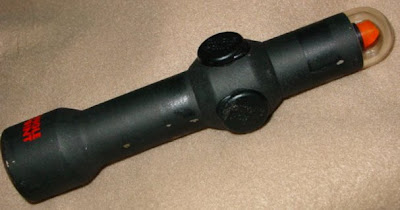Riot gun part 2: Pattern size
Personally, I like a wide open pattern.The whole reason for preferring a shotgun over a rifle is its hit probability and I don't intend to compromise that.
Is it better if your gun throws a broad, open pattern of shot or a small tight one? It isn't a simple question. The shotgun's hit probability, which is superior to any other small arm's at close range, owes to the spread of the shot. If you reduce the spread, you reduce the shotgun's advantage.
Things get more complicated, though, when you consider that a pattern that is too wide increases the number of pellets sailing past the target, doing you no good. Since pattern size increases with distance, a loose pattern loses effectiveness rapidly with range as the pattern's density degrades. What to do, what to do?
As a sort of baseline to the discussion, the riot gun for its first hundred years or so was almost always cylinder bored or Improved Cylinder choked, and threw open patterns, firing shells concocted with no special effort taken to keep the patterns tight. The usual rule of thumb is to say that such armament patterns about one inch per yard: A 30 yard pattern will be about 30 inches across, etc. Individual guns and batches of shotshells will do better or worse than the approximation.
The combination of an open choke and garden variety buckshot shells gained an awesome reputation over the years for cleaning up the bad guys, so we have to say it is not bad. Urban policing, jungle warfare, home defense, it did a good job for those roles and more.
In the mean time, sporting development of the shotgun proceeded in the direction of tighter patterns. Hunters of turkeys and ducks want patterns that are nice and tight, concentrating the pellets into a compact swarm. Shotshell advertisements extol this shell or that as throwing tight patterns. Choke makers offer various grades of tight, tighter and tightest. Custom gunsmiths will rebore your barrel for tighter tightness. Before long this thinking spilled over into fighting shotguns, and you now see some riot guns that are set up to throw buckshot in very small spreads.
Federal shotshells that contain the FliteControl wad, and Hornady shells with the VersaTite wad, offer unusually tight buckshot patterns even out of standard cylinder and IC guns. Actually both of these shells use the same patented wad technology, licensed from the inventor. These shells are very impressive, a definite advance if what you are looking for is tightly clustered hits.
With the options now available, in barrel work, chokes and ammunition, it is easy to shrink your pattern compared to the baseline performance of an open choke and plain old shells. That's fine if that's what you want, but it isn't what I want.
I will deal in a future installment with the question of pellets that miss and go sailing on their merry way. It appears to be less of a safety problem than some writers make of it. Remember, in this connection, that the open choked riot gun has been in use for more than a century. It is only recently that it occurred to us to worry about the question.
Personally, I like a wide open pattern.The whole reason for preferring a shotgun over a rifle is its hit probability and I don't intend to compromise that. Integral to this line of reasoning is the observation that most defense shootings are at short range--very short--and the spread from a cylinder or IC bore is likely none too wide for the circumstances. But here is a case where I can have my cake and eat it too. A supply of the tight patterning VersaTite or FliteControl shells turns my wide patterning, open choked gun into something that throws a pattern that is less than half the size. That is not what I want, usually, but it is nice to have the option with no more trouble on my part than poking different shells into the gun. My usual load, though, is just the plain old inch per yard buckshot. It's something that has worked well for a very long time.


Comments
Post a Comment